IFRS Implementation and Fair Value Accounting in Malaysia Report
VerifiedAdded on 2020/02/24
|14
|4239
|132
Report
AI Summary
This report provides a comprehensive analysis of International Financial Reporting Standards (IFRS) implementation in Malaysia, with a specific focus on fair value accounting as outlined in IFRS 13. The study explores the concept of fair value accounting, its underlying assumptions, and its significance ...
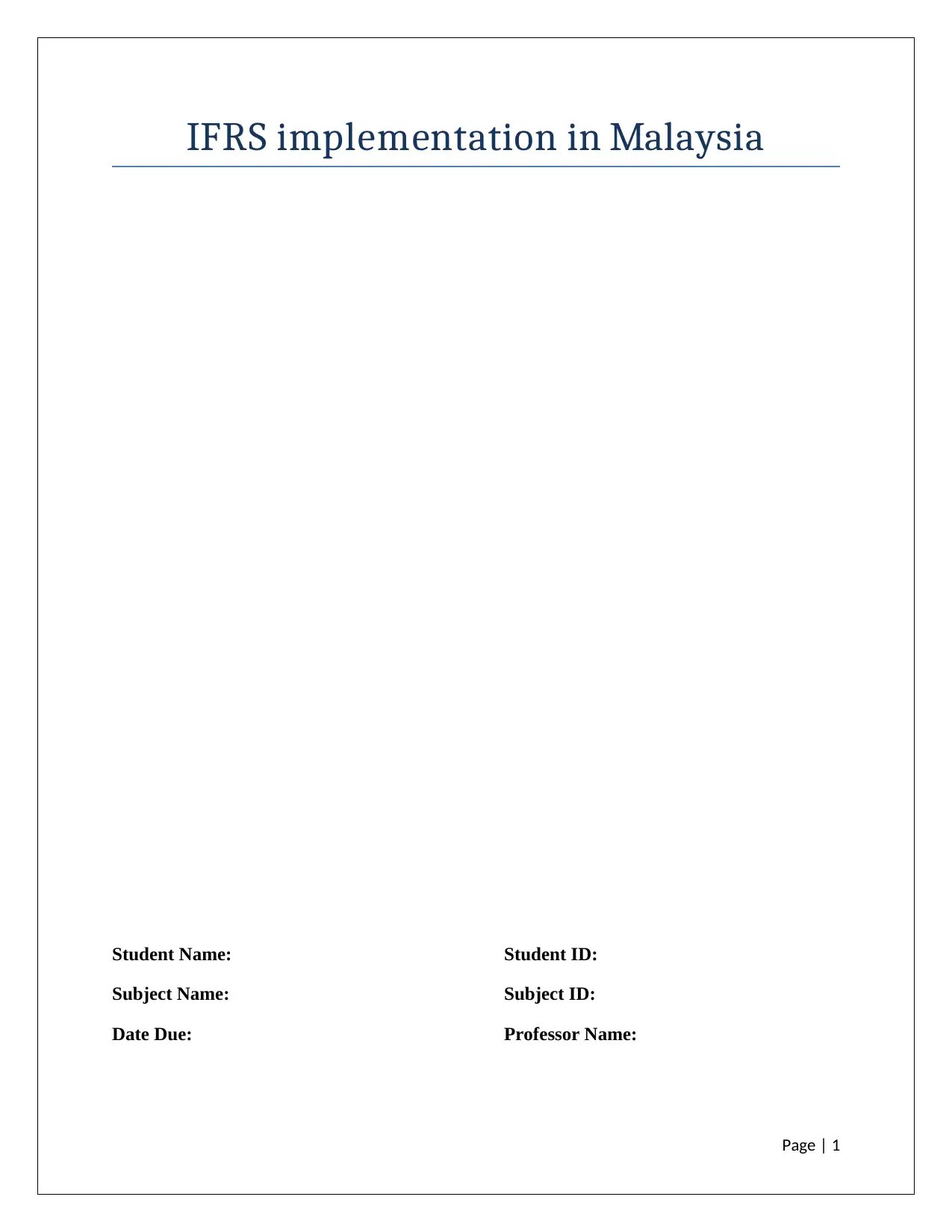
IFRS implementation in Malaysia
Student Name: Student ID:
Subject Name: Subject ID:
Date Due: Professor Name:
Page | 1
Student Name: Student ID:
Subject Name: Subject ID:
Date Due: Professor Name:
Page | 1
Paraphrase This Document
Need a fresh take? Get an instant paraphrase of this document with our AI Paraphraser
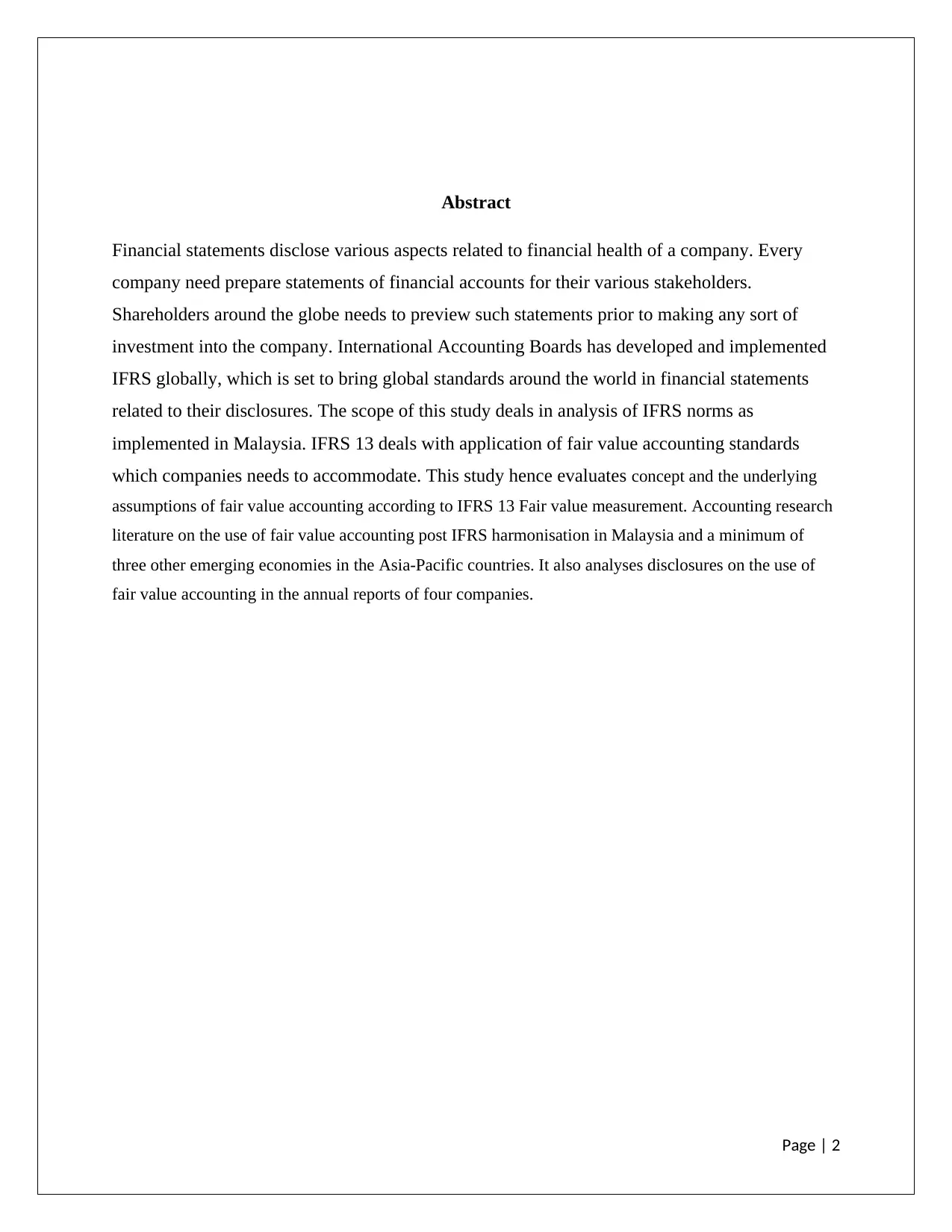
Abstract
Financial statements disclose various aspects related to financial health of a company. Every
company need prepare statements of financial accounts for their various stakeholders.
Shareholders around the globe needs to preview such statements prior to making any sort of
investment into the company. International Accounting Boards has developed and implemented
IFRS globally, which is set to bring global standards around the world in financial statements
related to their disclosures. The scope of this study deals in analysis of IFRS norms as
implemented in Malaysia. IFRS 13 deals with application of fair value accounting standards
which companies needs to accommodate. This study hence evaluates concept and the underlying
assumptions of fair value accounting according to IFRS 13 Fair value measurement. Accounting research
literature on the use of fair value accounting post IFRS harmonisation in Malaysia and a minimum of
three other emerging economies in the Asia-Pacific countries. It also analyses disclosures on the use of
fair value accounting in the annual reports of four companies.
Page | 2
Financial statements disclose various aspects related to financial health of a company. Every
company need prepare statements of financial accounts for their various stakeholders.
Shareholders around the globe needs to preview such statements prior to making any sort of
investment into the company. International Accounting Boards has developed and implemented
IFRS globally, which is set to bring global standards around the world in financial statements
related to their disclosures. The scope of this study deals in analysis of IFRS norms as
implemented in Malaysia. IFRS 13 deals with application of fair value accounting standards
which companies needs to accommodate. This study hence evaluates concept and the underlying
assumptions of fair value accounting according to IFRS 13 Fair value measurement. Accounting research
literature on the use of fair value accounting post IFRS harmonisation in Malaysia and a minimum of
three other emerging economies in the Asia-Pacific countries. It also analyses disclosures on the use of
fair value accounting in the annual reports of four companies.
Page | 2
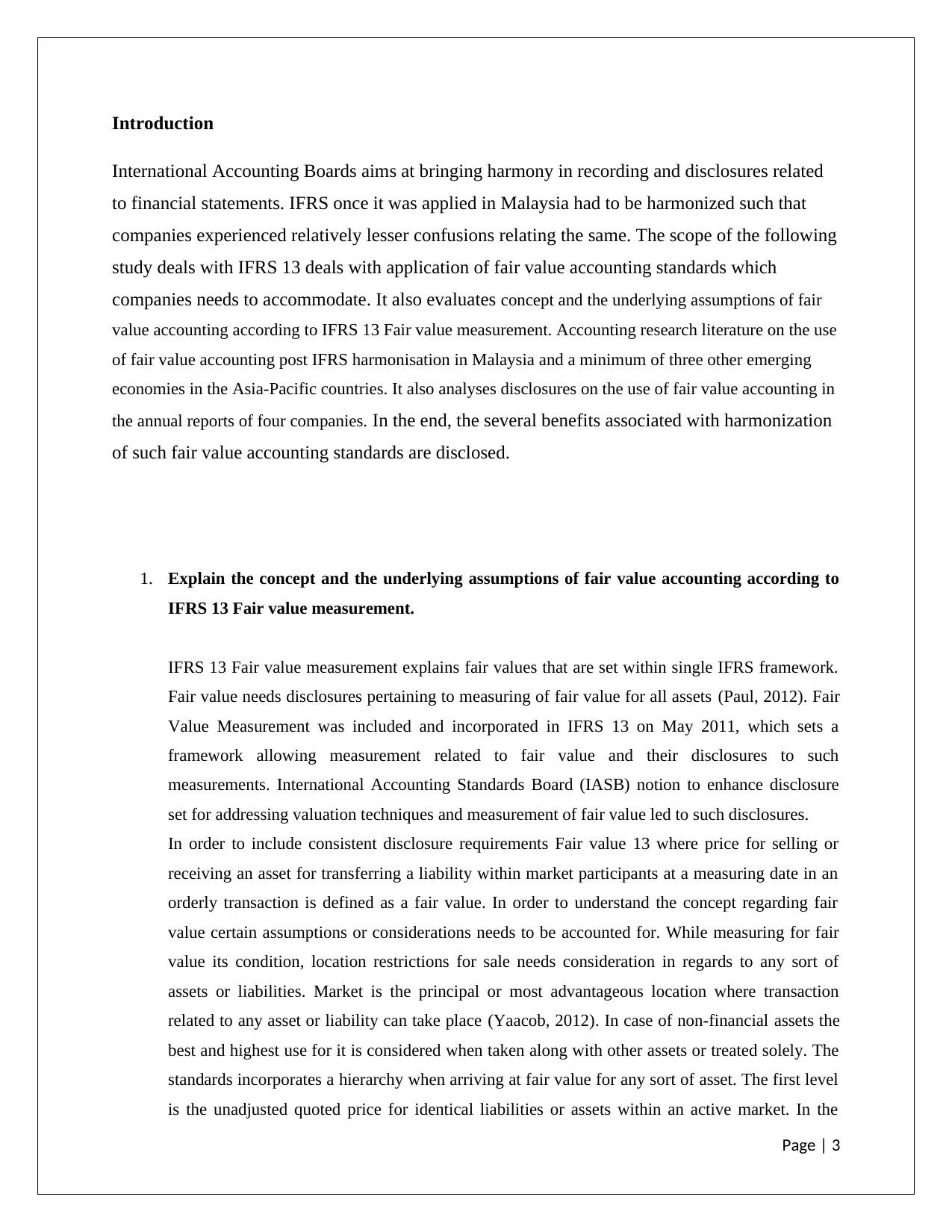
Introduction
International Accounting Boards aims at bringing harmony in recording and disclosures related
to financial statements. IFRS once it was applied in Malaysia had to be harmonized such that
companies experienced relatively lesser confusions relating the same. The scope of the following
study deals with IFRS 13 deals with application of fair value accounting standards which
companies needs to accommodate. It also evaluates concept and the underlying assumptions of fair
value accounting according to IFRS 13 Fair value measurement. Accounting research literature on the use
of fair value accounting post IFRS harmonisation in Malaysia and a minimum of three other emerging
economies in the Asia-Pacific countries. It also analyses disclosures on the use of fair value accounting in
the annual reports of four companies. In the end, the several benefits associated with harmonization
of such fair value accounting standards are disclosed.
1. Explain the concept and the underlying assumptions of fair value accounting according to
IFRS 13 Fair value measurement.
IFRS 13 Fair value measurement explains fair values that are set within single IFRS framework.
Fair value needs disclosures pertaining to measuring of fair value for all assets (Paul, 2012). Fair
Value Measurement was included and incorporated in IFRS 13 on May 2011, which sets a
framework allowing measurement related to fair value and their disclosures to such
measurements. International Accounting Standards Board (IASB) notion to enhance disclosure
set for addressing valuation techniques and measurement of fair value led to such disclosures.
In order to include consistent disclosure requirements Fair value 13 where price for selling or
receiving an asset for transferring a liability within market participants at a measuring date in an
orderly transaction is defined as a fair value. In order to understand the concept regarding fair
value certain assumptions or considerations needs to be accounted for. While measuring for fair
value its condition, location restrictions for sale needs consideration in regards to any sort of
assets or liabilities. Market is the principal or most advantageous location where transaction
related to any asset or liability can take place (Yaacob, 2012). In case of non-financial assets the
best and highest use for it is considered when taken along with other assets or treated solely. The
standards incorporates a hierarchy when arriving at fair value for any sort of asset. The first level
is the unadjusted quoted price for identical liabilities or assets within an active market. In the
Page | 3
International Accounting Boards aims at bringing harmony in recording and disclosures related
to financial statements. IFRS once it was applied in Malaysia had to be harmonized such that
companies experienced relatively lesser confusions relating the same. The scope of the following
study deals with IFRS 13 deals with application of fair value accounting standards which
companies needs to accommodate. It also evaluates concept and the underlying assumptions of fair
value accounting according to IFRS 13 Fair value measurement. Accounting research literature on the use
of fair value accounting post IFRS harmonisation in Malaysia and a minimum of three other emerging
economies in the Asia-Pacific countries. It also analyses disclosures on the use of fair value accounting in
the annual reports of four companies. In the end, the several benefits associated with harmonization
of such fair value accounting standards are disclosed.
1. Explain the concept and the underlying assumptions of fair value accounting according to
IFRS 13 Fair value measurement.
IFRS 13 Fair value measurement explains fair values that are set within single IFRS framework.
Fair value needs disclosures pertaining to measuring of fair value for all assets (Paul, 2012). Fair
Value Measurement was included and incorporated in IFRS 13 on May 2011, which sets a
framework allowing measurement related to fair value and their disclosures to such
measurements. International Accounting Standards Board (IASB) notion to enhance disclosure
set for addressing valuation techniques and measurement of fair value led to such disclosures.
In order to include consistent disclosure requirements Fair value 13 where price for selling or
receiving an asset for transferring a liability within market participants at a measuring date in an
orderly transaction is defined as a fair value. In order to understand the concept regarding fair
value certain assumptions or considerations needs to be accounted for. While measuring for fair
value its condition, location restrictions for sale needs consideration in regards to any sort of
assets or liabilities. Market is the principal or most advantageous location where transaction
related to any asset or liability can take place (Yaacob, 2012). In case of non-financial assets the
best and highest use for it is considered when taken along with other assets or treated solely. The
standards incorporates a hierarchy when arriving at fair value for any sort of asset. The first level
is the unadjusted quoted price for identical liabilities or assets within an active market. In the
Page | 3
⊘ This is a preview!⊘
Do you want full access?
Subscribe today to unlock all pages.

Trusted by 1+ million students worldwide
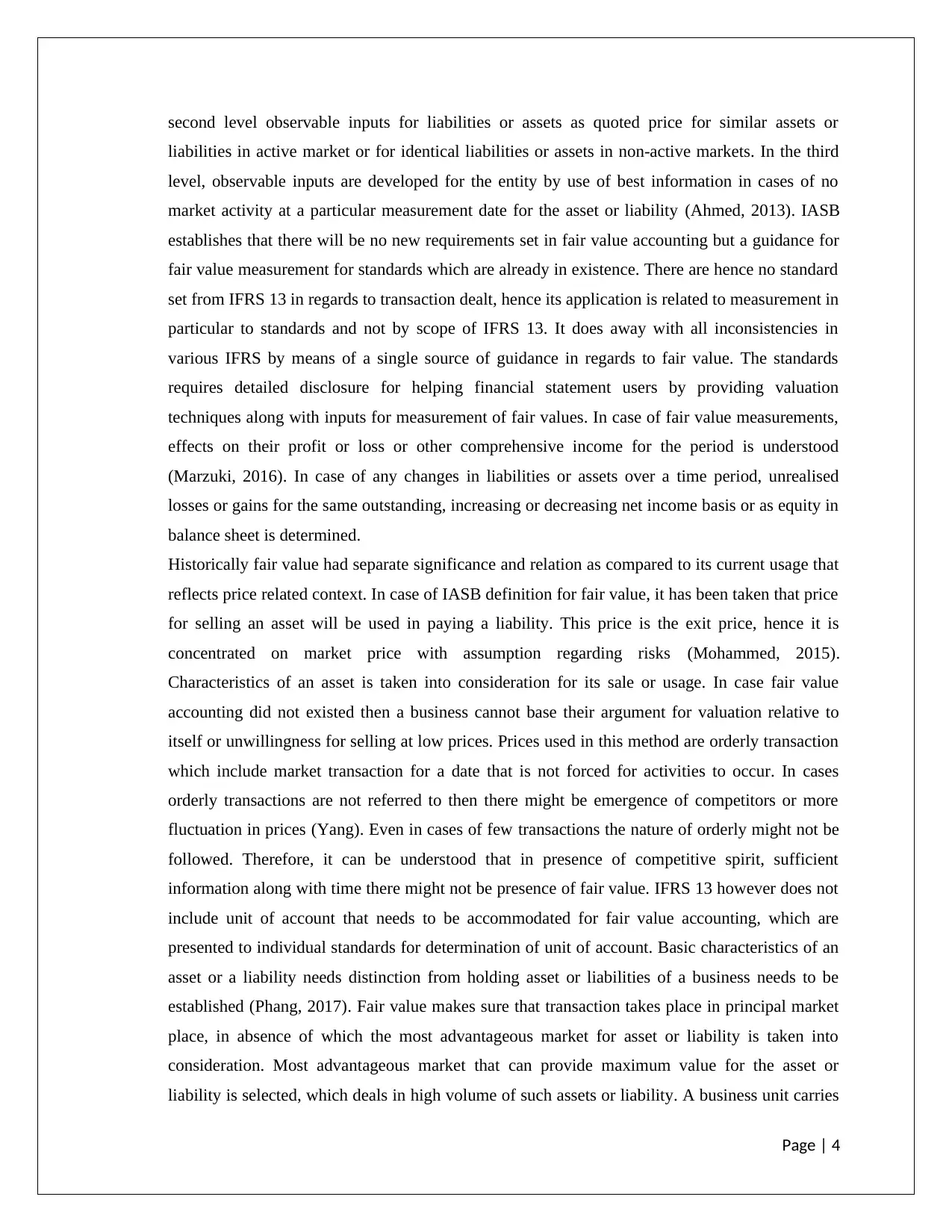
second level observable inputs for liabilities or assets as quoted price for similar assets or
liabilities in active market or for identical liabilities or assets in non-active markets. In the third
level, observable inputs are developed for the entity by use of best information in cases of no
market activity at a particular measurement date for the asset or liability (Ahmed, 2013). IASB
establishes that there will be no new requirements set in fair value accounting but a guidance for
fair value measurement for standards which are already in existence. There are hence no standard
set from IFRS 13 in regards to transaction dealt, hence its application is related to measurement in
particular to standards and not by scope of IFRS 13. It does away with all inconsistencies in
various IFRS by means of a single source of guidance in regards to fair value. The standards
requires detailed disclosure for helping financial statement users by providing valuation
techniques along with inputs for measurement of fair values. In case of fair value measurements,
effects on their profit or loss or other comprehensive income for the period is understood
(Marzuki, 2016). In case of any changes in liabilities or assets over a time period, unrealised
losses or gains for the same outstanding, increasing or decreasing net income basis or as equity in
balance sheet is determined.
Historically fair value had separate significance and relation as compared to its current usage that
reflects price related context. In case of IASB definition for fair value, it has been taken that price
for selling an asset will be used in paying a liability. This price is the exit price, hence it is
concentrated on market price with assumption regarding risks (Mohammed, 2015).
Characteristics of an asset is taken into consideration for its sale or usage. In case fair value
accounting did not existed then a business cannot base their argument for valuation relative to
itself or unwillingness for selling at low prices. Prices used in this method are orderly transaction
which include market transaction for a date that is not forced for activities to occur. In cases
orderly transactions are not referred to then there might be emergence of competitors or more
fluctuation in prices (Yang). Even in cases of few transactions the nature of orderly might not be
followed. Therefore, it can be understood that in presence of competitive spirit, sufficient
information along with time there might not be presence of fair value. IFRS 13 however does not
include unit of account that needs to be accommodated for fair value accounting, which are
presented to individual standards for determination of unit of account. Basic characteristics of an
asset or a liability needs distinction from holding asset or liabilities of a business needs to be
established (Phang, 2017). Fair value makes sure that transaction takes place in principal market
place, in absence of which the most advantageous market for asset or liability is taken into
consideration. Most advantageous market that can provide maximum value for the asset or
liability is selected, which deals in high volume of such assets or liability. A business unit carries
Page | 4
liabilities in active market or for identical liabilities or assets in non-active markets. In the third
level, observable inputs are developed for the entity by use of best information in cases of no
market activity at a particular measurement date for the asset or liability (Ahmed, 2013). IASB
establishes that there will be no new requirements set in fair value accounting but a guidance for
fair value measurement for standards which are already in existence. There are hence no standard
set from IFRS 13 in regards to transaction dealt, hence its application is related to measurement in
particular to standards and not by scope of IFRS 13. It does away with all inconsistencies in
various IFRS by means of a single source of guidance in regards to fair value. The standards
requires detailed disclosure for helping financial statement users by providing valuation
techniques along with inputs for measurement of fair values. In case of fair value measurements,
effects on their profit or loss or other comprehensive income for the period is understood
(Marzuki, 2016). In case of any changes in liabilities or assets over a time period, unrealised
losses or gains for the same outstanding, increasing or decreasing net income basis or as equity in
balance sheet is determined.
Historically fair value had separate significance and relation as compared to its current usage that
reflects price related context. In case of IASB definition for fair value, it has been taken that price
for selling an asset will be used in paying a liability. This price is the exit price, hence it is
concentrated on market price with assumption regarding risks (Mohammed, 2015).
Characteristics of an asset is taken into consideration for its sale or usage. In case fair value
accounting did not existed then a business cannot base their argument for valuation relative to
itself or unwillingness for selling at low prices. Prices used in this method are orderly transaction
which include market transaction for a date that is not forced for activities to occur. In cases
orderly transactions are not referred to then there might be emergence of competitors or more
fluctuation in prices (Yang). Even in cases of few transactions the nature of orderly might not be
followed. Therefore, it can be understood that in presence of competitive spirit, sufficient
information along with time there might not be presence of fair value. IFRS 13 however does not
include unit of account that needs to be accommodated for fair value accounting, which are
presented to individual standards for determination of unit of account. Basic characteristics of an
asset or a liability needs distinction from holding asset or liabilities of a business needs to be
established (Phang, 2017). Fair value makes sure that transaction takes place in principal market
place, in absence of which the most advantageous market for asset or liability is taken into
consideration. Most advantageous market that can provide maximum value for the asset or
liability is selected, which deals in high volume of such assets or liability. A business unit carries
Page | 4
Paraphrase This Document
Need a fresh take? Get an instant paraphrase of this document with our AI Paraphraser
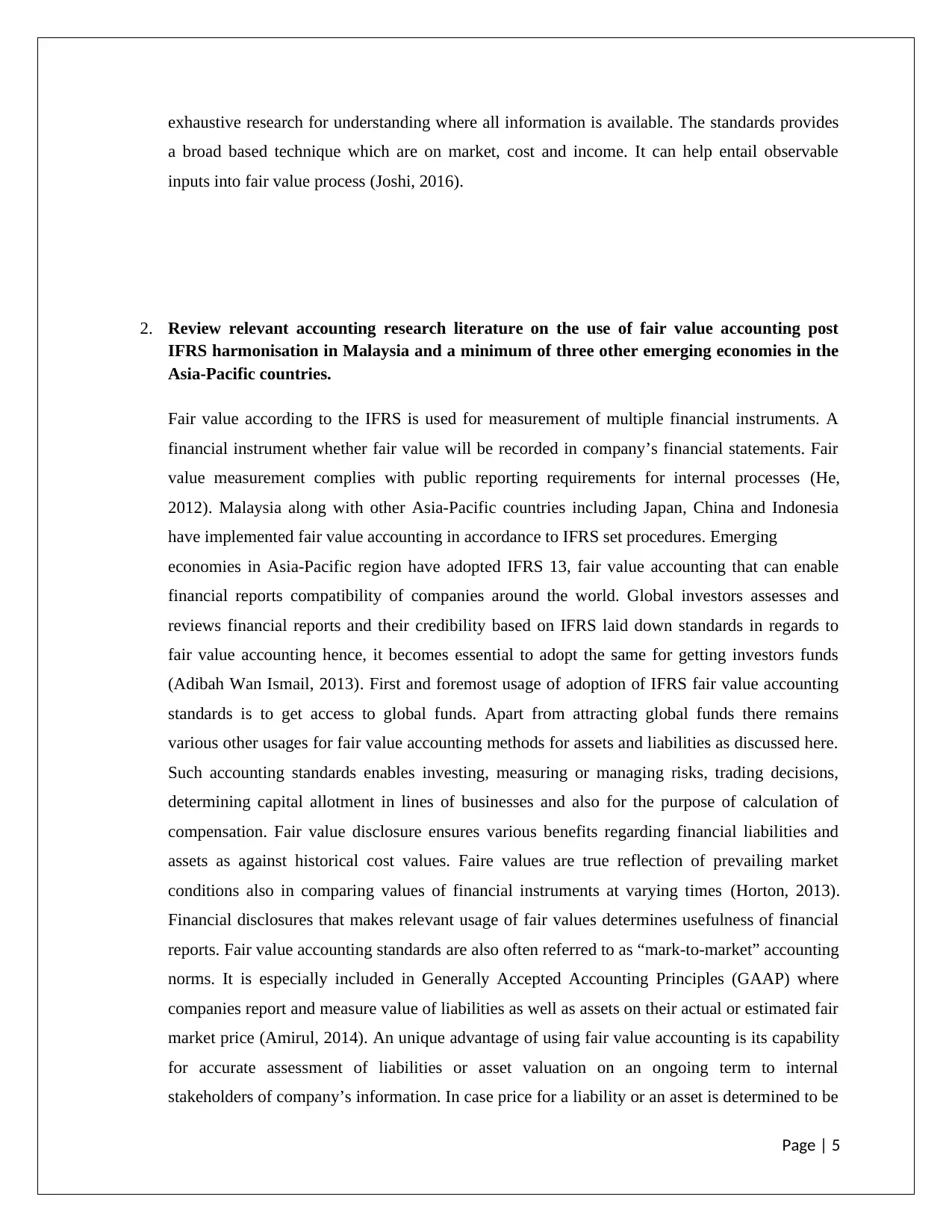
exhaustive research for understanding where all information is available. The standards provides
a broad based technique which are on market, cost and income. It can help entail observable
inputs into fair value process (Joshi, 2016).
2. Review relevant accounting research literature on the use of fair value accounting post
IFRS harmonisation in Malaysia and a minimum of three other emerging economies in the
Asia-Pacific countries.
Fair value according to the IFRS is used for measurement of multiple financial instruments. A
financial instrument whether fair value will be recorded in company’s financial statements. Fair
value measurement complies with public reporting requirements for internal processes (He,
2012). Malaysia along with other Asia-Pacific countries including Japan, China and Indonesia
have implemented fair value accounting in accordance to IFRS set procedures. Emerging
economies in Asia-Pacific region have adopted IFRS 13, fair value accounting that can enable
financial reports compatibility of companies around the world. Global investors assesses and
reviews financial reports and their credibility based on IFRS laid down standards in regards to
fair value accounting hence, it becomes essential to adopt the same for getting investors funds
(Adibah Wan Ismail, 2013). First and foremost usage of adoption of IFRS fair value accounting
standards is to get access to global funds. Apart from attracting global funds there remains
various other usages for fair value accounting methods for assets and liabilities as discussed here.
Such accounting standards enables investing, measuring or managing risks, trading decisions,
determining capital allotment in lines of businesses and also for the purpose of calculation of
compensation. Fair value disclosure ensures various benefits regarding financial liabilities and
assets as against historical cost values. Faire values are true reflection of prevailing market
conditions also in comparing values of financial instruments at varying times (Horton, 2013).
Financial disclosures that makes relevant usage of fair values determines usefulness of financial
reports. Fair value accounting standards are also often referred to as “mark-to-market” accounting
norms. It is especially included in Generally Accepted Accounting Principles (GAAP) where
companies report and measure value of liabilities as well as assets on their actual or estimated fair
market price (Amirul, 2014). An unique advantage of using fair value accounting is its capability
for accurate assessment of liabilities or asset valuation on an ongoing term to internal
stakeholders of company’s information. In case price for a liability or an asset is determined to be
Page | 5
a broad based technique which are on market, cost and income. It can help entail observable
inputs into fair value process (Joshi, 2016).
2. Review relevant accounting research literature on the use of fair value accounting post
IFRS harmonisation in Malaysia and a minimum of three other emerging economies in the
Asia-Pacific countries.
Fair value according to the IFRS is used for measurement of multiple financial instruments. A
financial instrument whether fair value will be recorded in company’s financial statements. Fair
value measurement complies with public reporting requirements for internal processes (He,
2012). Malaysia along with other Asia-Pacific countries including Japan, China and Indonesia
have implemented fair value accounting in accordance to IFRS set procedures. Emerging
economies in Asia-Pacific region have adopted IFRS 13, fair value accounting that can enable
financial reports compatibility of companies around the world. Global investors assesses and
reviews financial reports and their credibility based on IFRS laid down standards in regards to
fair value accounting hence, it becomes essential to adopt the same for getting investors funds
(Adibah Wan Ismail, 2013). First and foremost usage of adoption of IFRS fair value accounting
standards is to get access to global funds. Apart from attracting global funds there remains
various other usages for fair value accounting methods for assets and liabilities as discussed here.
Such accounting standards enables investing, measuring or managing risks, trading decisions,
determining capital allotment in lines of businesses and also for the purpose of calculation of
compensation. Fair value disclosure ensures various benefits regarding financial liabilities and
assets as against historical cost values. Faire values are true reflection of prevailing market
conditions also in comparing values of financial instruments at varying times (Horton, 2013).
Financial disclosures that makes relevant usage of fair values determines usefulness of financial
reports. Fair value accounting standards are also often referred to as “mark-to-market” accounting
norms. It is especially included in Generally Accepted Accounting Principles (GAAP) where
companies report and measure value of liabilities as well as assets on their actual or estimated fair
market price (Amirul, 2014). An unique advantage of using fair value accounting is its capability
for accurate assessment of liabilities or asset valuation on an ongoing term to internal
stakeholders of company’s information. In case price for a liability or an asset is determined to be
Page | 5
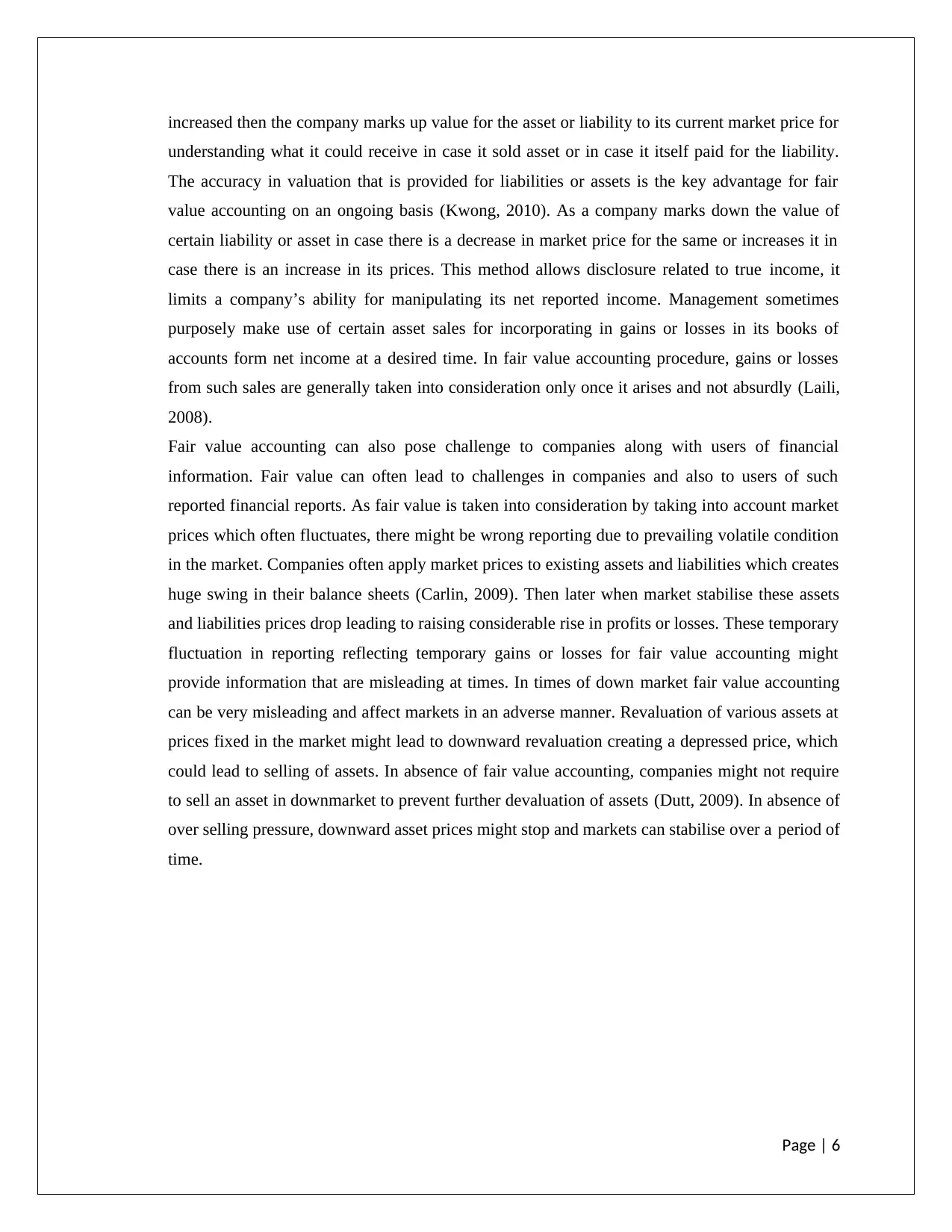
increased then the company marks up value for the asset or liability to its current market price for
understanding what it could receive in case it sold asset or in case it itself paid for the liability.
The accuracy in valuation that is provided for liabilities or assets is the key advantage for fair
value accounting on an ongoing basis (Kwong, 2010). As a company marks down the value of
certain liability or asset in case there is a decrease in market price for the same or increases it in
case there is an increase in its prices. This method allows disclosure related to true income, it
limits a company’s ability for manipulating its net reported income. Management sometimes
purposely make use of certain asset sales for incorporating in gains or losses in its books of
accounts form net income at a desired time. In fair value accounting procedure, gains or losses
from such sales are generally taken into consideration only once it arises and not absurdly (Laili,
2008).
Fair value accounting can also pose challenge to companies along with users of financial
information. Fair value can often lead to challenges in companies and also to users of such
reported financial reports. As fair value is taken into consideration by taking into account market
prices which often fluctuates, there might be wrong reporting due to prevailing volatile condition
in the market. Companies often apply market prices to existing assets and liabilities which creates
huge swing in their balance sheets (Carlin, 2009). Then later when market stabilise these assets
and liabilities prices drop leading to raising considerable rise in profits or losses. These temporary
fluctuation in reporting reflecting temporary gains or losses for fair value accounting might
provide information that are misleading at times. In times of down market fair value accounting
can be very misleading and affect markets in an adverse manner. Revaluation of various assets at
prices fixed in the market might lead to downward revaluation creating a depressed price, which
could lead to selling of assets. In absence of fair value accounting, companies might not require
to sell an asset in downmarket to prevent further devaluation of assets (Dutt, 2009). In absence of
over selling pressure, downward asset prices might stop and markets can stabilise over a period of
time.
Page | 6
understanding what it could receive in case it sold asset or in case it itself paid for the liability.
The accuracy in valuation that is provided for liabilities or assets is the key advantage for fair
value accounting on an ongoing basis (Kwong, 2010). As a company marks down the value of
certain liability or asset in case there is a decrease in market price for the same or increases it in
case there is an increase in its prices. This method allows disclosure related to true income, it
limits a company’s ability for manipulating its net reported income. Management sometimes
purposely make use of certain asset sales for incorporating in gains or losses in its books of
accounts form net income at a desired time. In fair value accounting procedure, gains or losses
from such sales are generally taken into consideration only once it arises and not absurdly (Laili,
2008).
Fair value accounting can also pose challenge to companies along with users of financial
information. Fair value can often lead to challenges in companies and also to users of such
reported financial reports. As fair value is taken into consideration by taking into account market
prices which often fluctuates, there might be wrong reporting due to prevailing volatile condition
in the market. Companies often apply market prices to existing assets and liabilities which creates
huge swing in their balance sheets (Carlin, 2009). Then later when market stabilise these assets
and liabilities prices drop leading to raising considerable rise in profits or losses. These temporary
fluctuation in reporting reflecting temporary gains or losses for fair value accounting might
provide information that are misleading at times. In times of down market fair value accounting
can be very misleading and affect markets in an adverse manner. Revaluation of various assets at
prices fixed in the market might lead to downward revaluation creating a depressed price, which
could lead to selling of assets. In absence of fair value accounting, companies might not require
to sell an asset in downmarket to prevent further devaluation of assets (Dutt, 2009). In absence of
over selling pressure, downward asset prices might stop and markets can stabilise over a period of
time.
Page | 6
⊘ This is a preview!⊘
Do you want full access?
Subscribe today to unlock all pages.

Trusted by 1+ million students worldwide
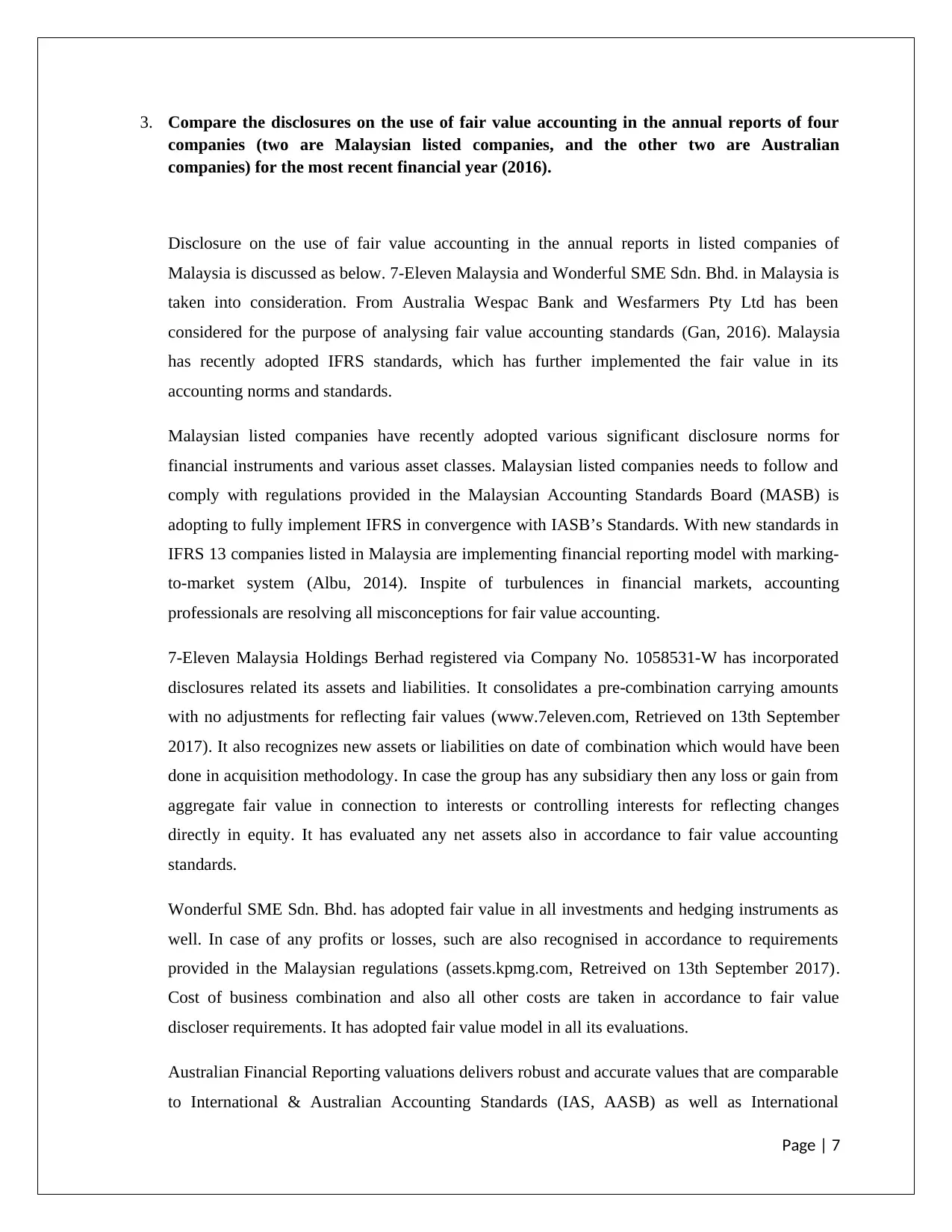
3. Compare the disclosures on the use of fair value accounting in the annual reports of four
companies (two are Malaysian listed companies, and the other two are Australian
companies) for the most recent financial year (2016).
Disclosure on the use of fair value accounting in the annual reports in listed companies of
Malaysia is discussed as below. 7-Eleven Malaysia and Wonderful SME Sdn. Bhd. in Malaysia is
taken into consideration. From Australia Wespac Bank and Wesfarmers Pty Ltd has been
considered for the purpose of analysing fair value accounting standards (Gan, 2016). Malaysia
has recently adopted IFRS standards, which has further implemented the fair value in its
accounting norms and standards.
Malaysian listed companies have recently adopted various significant disclosure norms for
financial instruments and various asset classes. Malaysian listed companies needs to follow and
comply with regulations provided in the Malaysian Accounting Standards Board (MASB) is
adopting to fully implement IFRS in convergence with IASB’s Standards. With new standards in
IFRS 13 companies listed in Malaysia are implementing financial reporting model with marking-
to-market system (Albu, 2014). Inspite of turbulences in financial markets, accounting
professionals are resolving all misconceptions for fair value accounting.
7-Eleven Malaysia Holdings Berhad registered via Company No. 1058531-W has incorporated
disclosures related its assets and liabilities. It consolidates a pre-combination carrying amounts
with no adjustments for reflecting fair values (www.7eleven.com, Retrieved on 13th September
2017). It also recognizes new assets or liabilities on date of combination which would have been
done in acquisition methodology. In case the group has any subsidiary then any loss or gain from
aggregate fair value in connection to interests or controlling interests for reflecting changes
directly in equity. It has evaluated any net assets also in accordance to fair value accounting
standards.
Wonderful SME Sdn. Bhd. has adopted fair value in all investments and hedging instruments as
well. In case of any profits or losses, such are also recognised in accordance to requirements
provided in the Malaysian regulations (assets.kpmg.com, Retreived on 13th September 2017).
Cost of business combination and also all other costs are taken in accordance to fair value
discloser requirements. It has adopted fair value model in all its evaluations.
Australian Financial Reporting valuations delivers robust and accurate values that are comparable
to International & Australian Accounting Standards (IAS, AASB) as well as International
Page | 7
companies (two are Malaysian listed companies, and the other two are Australian
companies) for the most recent financial year (2016).
Disclosure on the use of fair value accounting in the annual reports in listed companies of
Malaysia is discussed as below. 7-Eleven Malaysia and Wonderful SME Sdn. Bhd. in Malaysia is
taken into consideration. From Australia Wespac Bank and Wesfarmers Pty Ltd has been
considered for the purpose of analysing fair value accounting standards (Gan, 2016). Malaysia
has recently adopted IFRS standards, which has further implemented the fair value in its
accounting norms and standards.
Malaysian listed companies have recently adopted various significant disclosure norms for
financial instruments and various asset classes. Malaysian listed companies needs to follow and
comply with regulations provided in the Malaysian Accounting Standards Board (MASB) is
adopting to fully implement IFRS in convergence with IASB’s Standards. With new standards in
IFRS 13 companies listed in Malaysia are implementing financial reporting model with marking-
to-market system (Albu, 2014). Inspite of turbulences in financial markets, accounting
professionals are resolving all misconceptions for fair value accounting.
7-Eleven Malaysia Holdings Berhad registered via Company No. 1058531-W has incorporated
disclosures related its assets and liabilities. It consolidates a pre-combination carrying amounts
with no adjustments for reflecting fair values (www.7eleven.com, Retrieved on 13th September
2017). It also recognizes new assets or liabilities on date of combination which would have been
done in acquisition methodology. In case the group has any subsidiary then any loss or gain from
aggregate fair value in connection to interests or controlling interests for reflecting changes
directly in equity. It has evaluated any net assets also in accordance to fair value accounting
standards.
Wonderful SME Sdn. Bhd. has adopted fair value in all investments and hedging instruments as
well. In case of any profits or losses, such are also recognised in accordance to requirements
provided in the Malaysian regulations (assets.kpmg.com, Retreived on 13th September 2017).
Cost of business combination and also all other costs are taken in accordance to fair value
discloser requirements. It has adopted fair value model in all its evaluations.
Australian Financial Reporting valuations delivers robust and accurate values that are comparable
to International & Australian Accounting Standards (IAS, AASB) as well as International
Page | 7
Paraphrase This Document
Need a fresh take? Get an instant paraphrase of this document with our AI Paraphraser
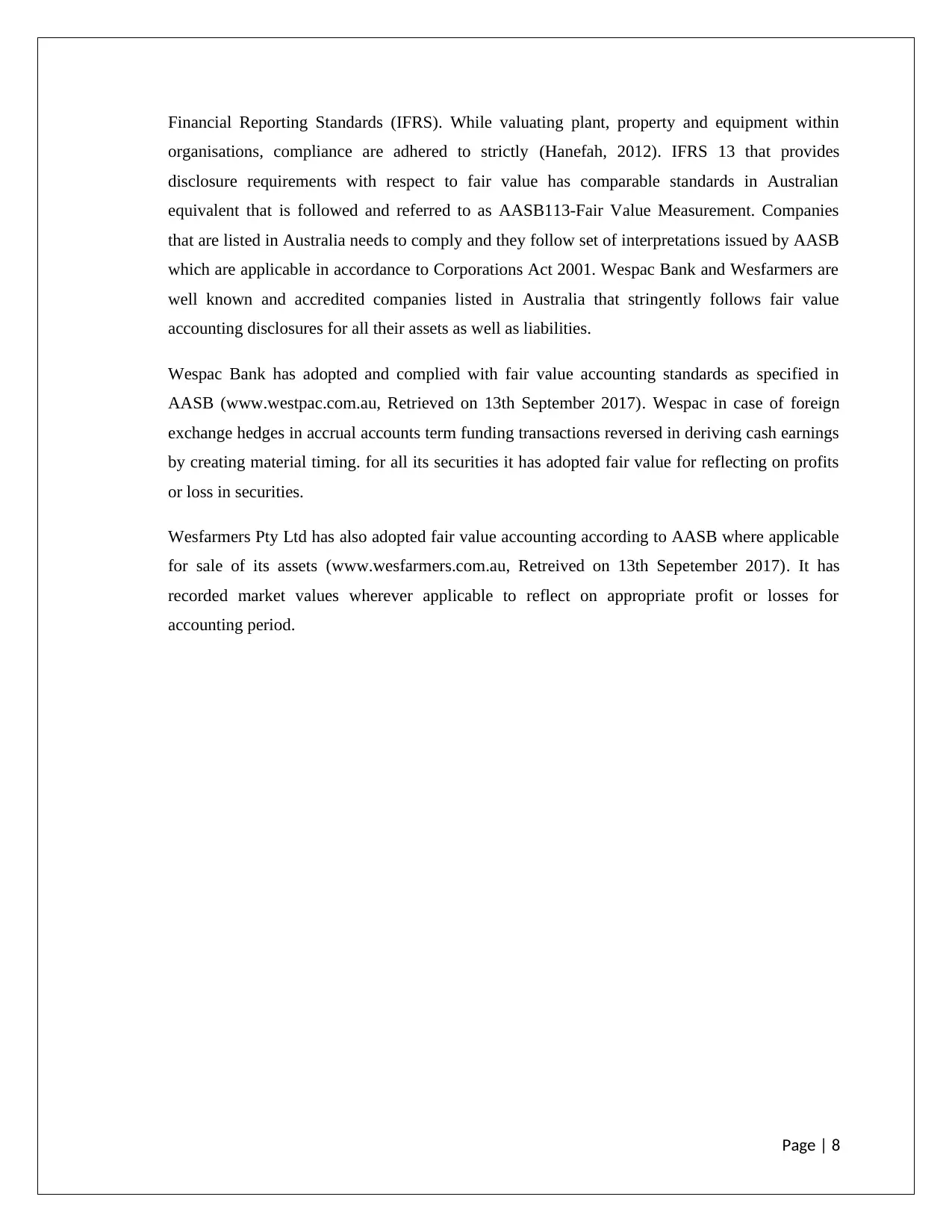
Financial Reporting Standards (IFRS). While valuating plant, property and equipment within
organisations, compliance are adhered to strictly (Hanefah, 2012). IFRS 13 that provides
disclosure requirements with respect to fair value has comparable standards in Australian
equivalent that is followed and referred to as AASB113-Fair Value Measurement. Companies
that are listed in Australia needs to comply and they follow set of interpretations issued by AASB
which are applicable in accordance to Corporations Act 2001. Wespac Bank and Wesfarmers are
well known and accredited companies listed in Australia that stringently follows fair value
accounting disclosures for all their assets as well as liabilities.
Wespac Bank has adopted and complied with fair value accounting standards as specified in
AASB (www.westpac.com.au, Retrieved on 13th September 2017). Wespac in case of foreign
exchange hedges in accrual accounts term funding transactions reversed in deriving cash earnings
by creating material timing. for all its securities it has adopted fair value for reflecting on profits
or loss in securities.
Wesfarmers Pty Ltd has also adopted fair value accounting according to AASB where applicable
for sale of its assets (www.wesfarmers.com.au, Retreived on 13th Sepetember 2017). It has
recorded market values wherever applicable to reflect on appropriate profit or losses for
accounting period.
Page | 8
organisations, compliance are adhered to strictly (Hanefah, 2012). IFRS 13 that provides
disclosure requirements with respect to fair value has comparable standards in Australian
equivalent that is followed and referred to as AASB113-Fair Value Measurement. Companies
that are listed in Australia needs to comply and they follow set of interpretations issued by AASB
which are applicable in accordance to Corporations Act 2001. Wespac Bank and Wesfarmers are
well known and accredited companies listed in Australia that stringently follows fair value
accounting disclosures for all their assets as well as liabilities.
Wespac Bank has adopted and complied with fair value accounting standards as specified in
AASB (www.westpac.com.au, Retrieved on 13th September 2017). Wespac in case of foreign
exchange hedges in accrual accounts term funding transactions reversed in deriving cash earnings
by creating material timing. for all its securities it has adopted fair value for reflecting on profits
or loss in securities.
Wesfarmers Pty Ltd has also adopted fair value accounting according to AASB where applicable
for sale of its assets (www.wesfarmers.com.au, Retreived on 13th Sepetember 2017). It has
recorded market values wherever applicable to reflect on appropriate profit or losses for
accounting period.
Page | 8

4. Discuss if your findings support (or reject) the view that the use of fair value accounting
since IFRS harmonisation in Malaysia has improved the quality of information disclosure.
Malaysia has successfully incorporated fair value accounting standards in all its forms.
Incorporation of IFRS in Malaysia has allowed companies to accommodate and include
multiple norms and standards in regards to fair value accounting means (Halim Kadri,
2009). Currently companies in Malaysia, mostly that are listed make use of fair value in
accounting for disclosing their valuation of assets and liabilities. This has been able to
attract considerable number of investors, shareholders and other agencies to these
companies as they now represent at par standards with rest of the world. With
harmonization of IFRS accounting standards in Malaysia, quality of information
disclosure has improved significantly. Generally accepted worldwide that adopting
International Financial Reporting Standards (IFRS) results in improving of quality of
financial reporting (Siswantoro, 2012). As such, reports are more compatible and can
have serious economic consequences, hence this gross generalization on IFRS is highly
approved. Insights into adoption of IFRS standards to harmonize accounting standards
has led to serious debate amongst multiple countries. Economic consequences following
adoption of IFRS differs significantly across jurisdictions or countries. IFRS have been
noted to supersede standards in quality of financial reporting from various countries
accounting standards (Ibarra, 2011). IFRS can also result in reduction in costs of capital
that is enhanced by way of incentives from financial reporting, legal systems prevailing,
capital market characteristics, law enforcements and so on. Various scholars are however
opposed to the idea of quality standards as evident in IFRS but in Malaysia application of
fair value accounting has significantly raised quality standards in the country.
Malaysian financial disclosure and norms that existed prior to adoption of IFRS provided
for historical cost recording for assets as well as liabilities. Due to recording of historical
costs for assets or liabilities, financial records and statement of accounts often disclosed
faulty profits or losses (Muniandy, 2012). Such profits used to carried forward for years
and then with sale of such assets, companies used to have large losses that is not absorbed
in its financial statements. Recording assets and liabilities in according to historical costs
also led to tax liability for these companies as they had large proportion of profits, which
was not real in nature. Further such large tax payment later upon sale of the asset resulted
Page | 9
since IFRS harmonisation in Malaysia has improved the quality of information disclosure.
Malaysia has successfully incorporated fair value accounting standards in all its forms.
Incorporation of IFRS in Malaysia has allowed companies to accommodate and include
multiple norms and standards in regards to fair value accounting means (Halim Kadri,
2009). Currently companies in Malaysia, mostly that are listed make use of fair value in
accounting for disclosing their valuation of assets and liabilities. This has been able to
attract considerable number of investors, shareholders and other agencies to these
companies as they now represent at par standards with rest of the world. With
harmonization of IFRS accounting standards in Malaysia, quality of information
disclosure has improved significantly. Generally accepted worldwide that adopting
International Financial Reporting Standards (IFRS) results in improving of quality of
financial reporting (Siswantoro, 2012). As such, reports are more compatible and can
have serious economic consequences, hence this gross generalization on IFRS is highly
approved. Insights into adoption of IFRS standards to harmonize accounting standards
has led to serious debate amongst multiple countries. Economic consequences following
adoption of IFRS differs significantly across jurisdictions or countries. IFRS have been
noted to supersede standards in quality of financial reporting from various countries
accounting standards (Ibarra, 2011). IFRS can also result in reduction in costs of capital
that is enhanced by way of incentives from financial reporting, legal systems prevailing,
capital market characteristics, law enforcements and so on. Various scholars are however
opposed to the idea of quality standards as evident in IFRS but in Malaysia application of
fair value accounting has significantly raised quality standards in the country.
Malaysian financial disclosure and norms that existed prior to adoption of IFRS provided
for historical cost recording for assets as well as liabilities. Due to recording of historical
costs for assets or liabilities, financial records and statement of accounts often disclosed
faulty profits or losses (Muniandy, 2012). Such profits used to carried forward for years
and then with sale of such assets, companies used to have large losses that is not absorbed
in its financial statements. Recording assets and liabilities in according to historical costs
also led to tax liability for these companies as they had large proportion of profits, which
was not real in nature. Further such large tax payment later upon sale of the asset resulted
Page | 9
⊘ This is a preview!⊘
Do you want full access?
Subscribe today to unlock all pages.

Trusted by 1+ million students worldwide
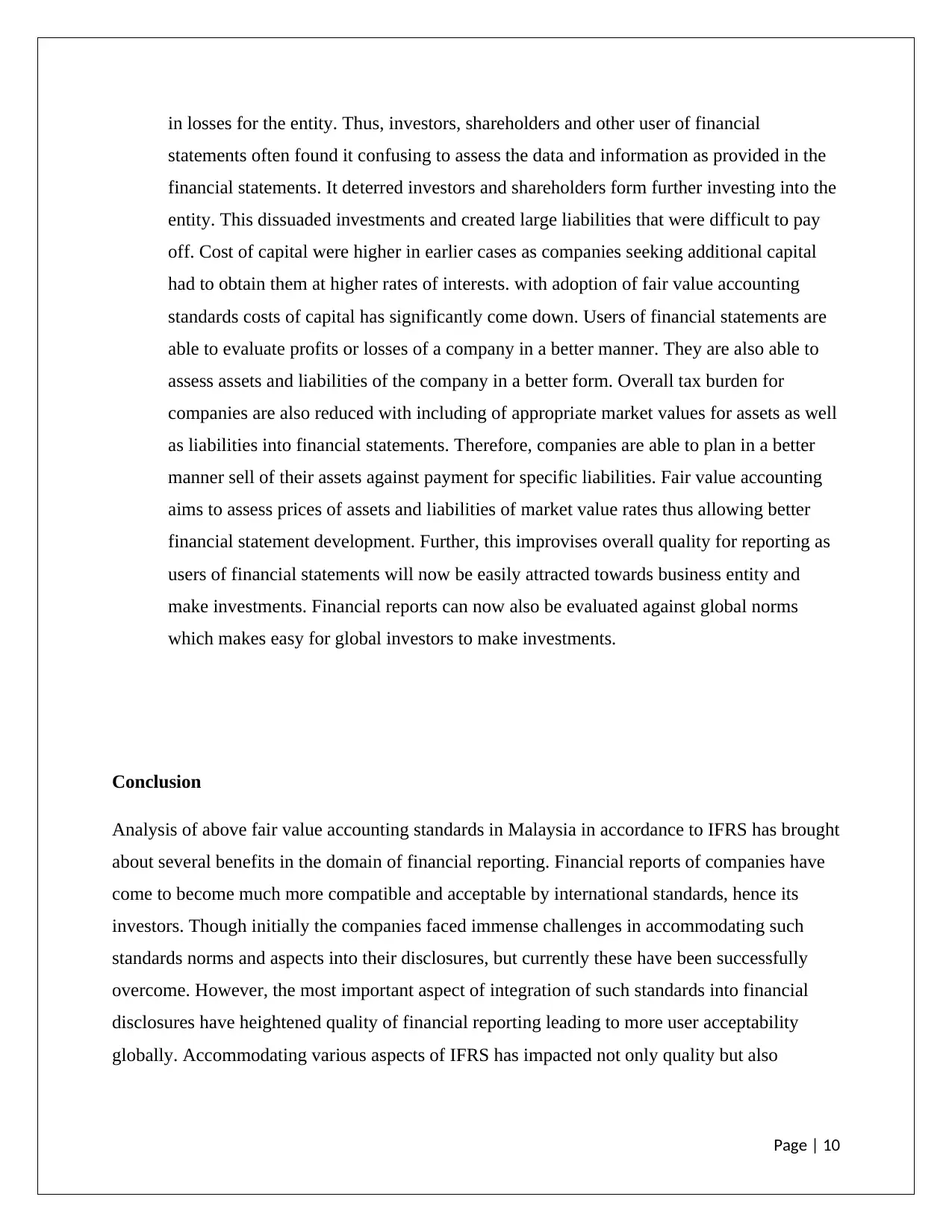
in losses for the entity. Thus, investors, shareholders and other user of financial
statements often found it confusing to assess the data and information as provided in the
financial statements. It deterred investors and shareholders form further investing into the
entity. This dissuaded investments and created large liabilities that were difficult to pay
off. Cost of capital were higher in earlier cases as companies seeking additional capital
had to obtain them at higher rates of interests. with adoption of fair value accounting
standards costs of capital has significantly come down. Users of financial statements are
able to evaluate profits or losses of a company in a better manner. They are also able to
assess assets and liabilities of the company in a better form. Overall tax burden for
companies are also reduced with including of appropriate market values for assets as well
as liabilities into financial statements. Therefore, companies are able to plan in a better
manner sell of their assets against payment for specific liabilities. Fair value accounting
aims to assess prices of assets and liabilities of market value rates thus allowing better
financial statement development. Further, this improvises overall quality for reporting as
users of financial statements will now be easily attracted towards business entity and
make investments. Financial reports can now also be evaluated against global norms
which makes easy for global investors to make investments.
Conclusion
Analysis of above fair value accounting standards in Malaysia in accordance to IFRS has brought
about several benefits in the domain of financial reporting. Financial reports of companies have
come to become much more compatible and acceptable by international standards, hence its
investors. Though initially the companies faced immense challenges in accommodating such
standards norms and aspects into their disclosures, but currently these have been successfully
overcome. However, the most important aspect of integration of such standards into financial
disclosures have heightened quality of financial reporting leading to more user acceptability
globally. Accommodating various aspects of IFRS has impacted not only quality but also
Page | 10
statements often found it confusing to assess the data and information as provided in the
financial statements. It deterred investors and shareholders form further investing into the
entity. This dissuaded investments and created large liabilities that were difficult to pay
off. Cost of capital were higher in earlier cases as companies seeking additional capital
had to obtain them at higher rates of interests. with adoption of fair value accounting
standards costs of capital has significantly come down. Users of financial statements are
able to evaluate profits or losses of a company in a better manner. They are also able to
assess assets and liabilities of the company in a better form. Overall tax burden for
companies are also reduced with including of appropriate market values for assets as well
as liabilities into financial statements. Therefore, companies are able to plan in a better
manner sell of their assets against payment for specific liabilities. Fair value accounting
aims to assess prices of assets and liabilities of market value rates thus allowing better
financial statement development. Further, this improvises overall quality for reporting as
users of financial statements will now be easily attracted towards business entity and
make investments. Financial reports can now also be evaluated against global norms
which makes easy for global investors to make investments.
Conclusion
Analysis of above fair value accounting standards in Malaysia in accordance to IFRS has brought
about several benefits in the domain of financial reporting. Financial reports of companies have
come to become much more compatible and acceptable by international standards, hence its
investors. Though initially the companies faced immense challenges in accommodating such
standards norms and aspects into their disclosures, but currently these have been successfully
overcome. However, the most important aspect of integration of such standards into financial
disclosures have heightened quality of financial reporting leading to more user acceptability
globally. Accommodating various aspects of IFRS has impacted not only quality but also
Page | 10
Paraphrase This Document
Need a fresh take? Get an instant paraphrase of this document with our AI Paraphraser
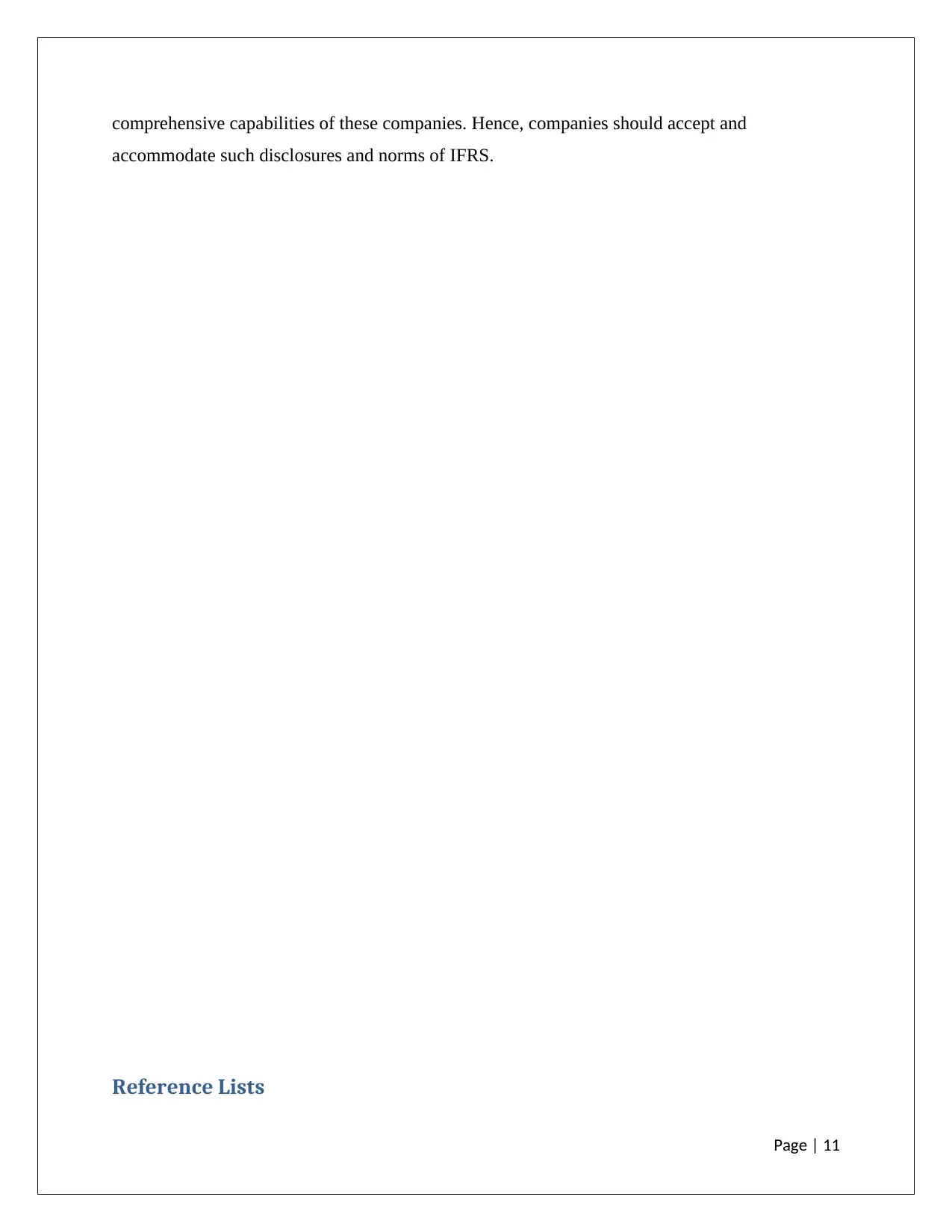
comprehensive capabilities of these companies. Hence, companies should accept and
accommodate such disclosures and norms of IFRS.
Reference Lists
Page | 11
accommodate such disclosures and norms of IFRS.
Reference Lists
Page | 11

Adibah Wan Ismail, W. A. 2013. Earnings quality and the adoption of IFRS-based accounting
standards: Evidence from an emerging market. Asian Review of Accounting, 53-73.
Ahmed, K. C. 2013. A meta-analysis of IFRS adoption effects. The International Journal of
Accounting, 173-217.
Albu, C. N. 2014. When global accounting standards meet the local context—Insights from an
emerging economy. Critical Perspectives on Accounting, 489-510.
Amirul, S. M. 2014. Convergence to IFRs and audit report lag in Malaysia. . Convergence.
assets.kpmg.com. (Retreived on 13th September 2017). kpmg.
https://assets.kpmg.com/content/dam/kpmg/my/pdf/Wonderful-SME-Sdn-Bhd-Illustrative-
Financial-Statements-2016.pdf.
Carlin, T. M. 2009. Goodwill accounting in Malaysia and the transition to IFRS–A compliance
assessment of large first year adopters. Journal of Financial Reporting and Accounting, 75-104.
Dutt, S. 2009. IFRS Convergence Update (Malaysia). In IFRS Conference: Seoul (Vol. 29).
Gan, C. Y. 2016. Impacts of FRS139 adoption on value relevance of financial reporting in
Malaysia. Managerial Finance, 706-721.
Halim Kadri, M. A. 2009. Value relevance of book value and earnings: evidence from two
different financial reporting regimes. Journal of Financial Reporting and Accounting, 1-16.
Hanefah, H. M. 2012. Convergence towards IFRS in Malaysia: Issues, challenges and
opportunities. International Journal of Business, Economics and Law, 85-91.
He, X. W. 2012. Challenges for implementation of fair value accounting in emerging markets:
Evidence from China. Contemporary Accounting Research, 538-562.
Horton, J. S. 2013. Does mandatory IFRS adoption improve the information environment?
Contemporary Accounting Research, 388-423.
Page | 12
standards: Evidence from an emerging market. Asian Review of Accounting, 53-73.
Ahmed, K. C. 2013. A meta-analysis of IFRS adoption effects. The International Journal of
Accounting, 173-217.
Albu, C. N. 2014. When global accounting standards meet the local context—Insights from an
emerging economy. Critical Perspectives on Accounting, 489-510.
Amirul, S. M. 2014. Convergence to IFRs and audit report lag in Malaysia. . Convergence.
assets.kpmg.com. (Retreived on 13th September 2017). kpmg.
https://assets.kpmg.com/content/dam/kpmg/my/pdf/Wonderful-SME-Sdn-Bhd-Illustrative-
Financial-Statements-2016.pdf.
Carlin, T. M. 2009. Goodwill accounting in Malaysia and the transition to IFRS–A compliance
assessment of large first year adopters. Journal of Financial Reporting and Accounting, 75-104.
Dutt, S. 2009. IFRS Convergence Update (Malaysia). In IFRS Conference: Seoul (Vol. 29).
Gan, C. Y. 2016. Impacts of FRS139 adoption on value relevance of financial reporting in
Malaysia. Managerial Finance, 706-721.
Halim Kadri, M. A. 2009. Value relevance of book value and earnings: evidence from two
different financial reporting regimes. Journal of Financial Reporting and Accounting, 1-16.
Hanefah, H. M. 2012. Convergence towards IFRS in Malaysia: Issues, challenges and
opportunities. International Journal of Business, Economics and Law, 85-91.
He, X. W. 2012. Challenges for implementation of fair value accounting in emerging markets:
Evidence from China. Contemporary Accounting Research, 538-562.
Horton, J. S. 2013. Does mandatory IFRS adoption improve the information environment?
Contemporary Accounting Research, 388-423.
Page | 12
⊘ This is a preview!⊘
Do you want full access?
Subscribe today to unlock all pages.

Trusted by 1+ million students worldwide
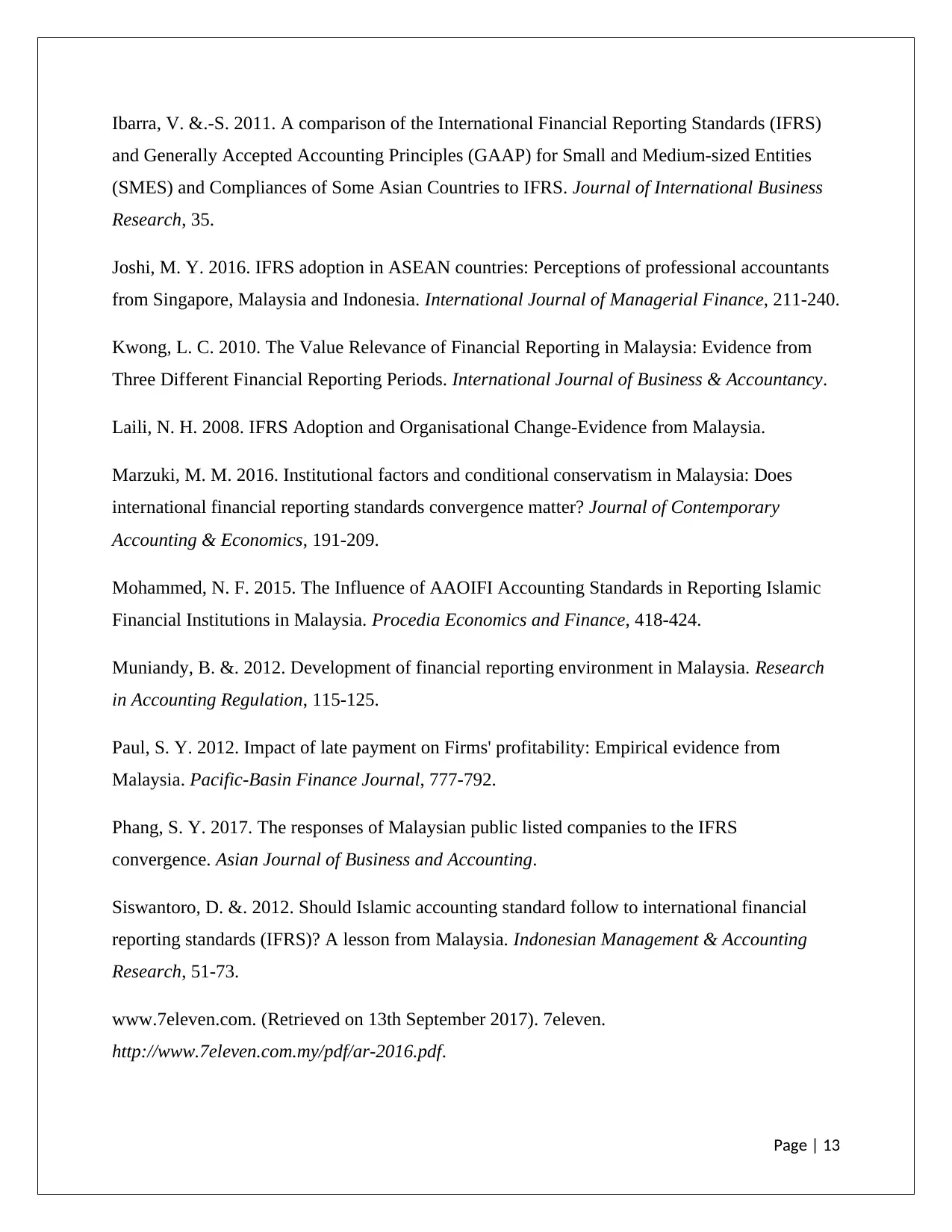
Ibarra, V. &.-S. 2011. A comparison of the International Financial Reporting Standards (IFRS)
and Generally Accepted Accounting Principles (GAAP) for Small and Medium-sized Entities
(SMES) and Compliances of Some Asian Countries to IFRS. Journal of International Business
Research, 35.
Joshi, M. Y. 2016. IFRS adoption in ASEAN countries: Perceptions of professional accountants
from Singapore, Malaysia and Indonesia. International Journal of Managerial Finance, 211-240.
Kwong, L. C. 2010. The Value Relevance of Financial Reporting in Malaysia: Evidence from
Three Different Financial Reporting Periods. International Journal of Business & Accountancy.
Laili, N. H. 2008. IFRS Adoption and Organisational Change-Evidence from Malaysia.
Marzuki, M. M. 2016. Institutional factors and conditional conservatism in Malaysia: Does
international financial reporting standards convergence matter? Journal of Contemporary
Accounting & Economics, 191-209.
Mohammed, N. F. 2015. The Influence of AAOIFI Accounting Standards in Reporting Islamic
Financial Institutions in Malaysia. Procedia Economics and Finance, 418-424.
Muniandy, B. &. 2012. Development of financial reporting environment in Malaysia. Research
in Accounting Regulation, 115-125.
Paul, S. Y. 2012. Impact of late payment on Firms' profitability: Empirical evidence from
Malaysia. Pacific-Basin Finance Journal, 777-792.
Phang, S. Y. 2017. The responses of Malaysian public listed companies to the IFRS
convergence. Asian Journal of Business and Accounting.
Siswantoro, D. &. 2012. Should Islamic accounting standard follow to international financial
reporting standards (IFRS)? A lesson from Malaysia. Indonesian Management & Accounting
Research, 51-73.
www.7eleven.com. (Retrieved on 13th September 2017). 7eleven.
http://www.7eleven.com.my/pdf/ar-2016.pdf.
Page | 13
and Generally Accepted Accounting Principles (GAAP) for Small and Medium-sized Entities
(SMES) and Compliances of Some Asian Countries to IFRS. Journal of International Business
Research, 35.
Joshi, M. Y. 2016. IFRS adoption in ASEAN countries: Perceptions of professional accountants
from Singapore, Malaysia and Indonesia. International Journal of Managerial Finance, 211-240.
Kwong, L. C. 2010. The Value Relevance of Financial Reporting in Malaysia: Evidence from
Three Different Financial Reporting Periods. International Journal of Business & Accountancy.
Laili, N. H. 2008. IFRS Adoption and Organisational Change-Evidence from Malaysia.
Marzuki, M. M. 2016. Institutional factors and conditional conservatism in Malaysia: Does
international financial reporting standards convergence matter? Journal of Contemporary
Accounting & Economics, 191-209.
Mohammed, N. F. 2015. The Influence of AAOIFI Accounting Standards in Reporting Islamic
Financial Institutions in Malaysia. Procedia Economics and Finance, 418-424.
Muniandy, B. &. 2012. Development of financial reporting environment in Malaysia. Research
in Accounting Regulation, 115-125.
Paul, S. Y. 2012. Impact of late payment on Firms' profitability: Empirical evidence from
Malaysia. Pacific-Basin Finance Journal, 777-792.
Phang, S. Y. 2017. The responses of Malaysian public listed companies to the IFRS
convergence. Asian Journal of Business and Accounting.
Siswantoro, D. &. 2012. Should Islamic accounting standard follow to international financial
reporting standards (IFRS)? A lesson from Malaysia. Indonesian Management & Accounting
Research, 51-73.
www.7eleven.com. (Retrieved on 13th September 2017). 7eleven.
http://www.7eleven.com.my/pdf/ar-2016.pdf.
Page | 13
Paraphrase This Document
Need a fresh take? Get an instant paraphrase of this document with our AI Paraphraser

www.wesfarmers.com.au. (Retreived on 13th Sepetember 2017). wesfarmers.
https://www.wesfarmers.com.au/docs/default-source/reports/2016-annual-report.pdf?sfvrsn=4.
www.westpac.com.au. (Retrieved on 13th September 2017). Westpac Bank.
https://www.westpac.com.au/content/dam/public/wbc/documents/pdf/aw/ic/financial-
information/FY16_final_presentation_and_idp_asx.pdf.
Yaacob, N. M.-A. 2012. Adoption of FRS 138 and audit delay in Malaysia. International
Journal of Economics and Finance, 167.
Yang, H. H. n.d.. Insights from Accounting Practitioners on China's Convergence with IFRS.
Australian Accounting Review.
Page | 14
https://www.wesfarmers.com.au/docs/default-source/reports/2016-annual-report.pdf?sfvrsn=4.
www.westpac.com.au. (Retrieved on 13th September 2017). Westpac Bank.
https://www.westpac.com.au/content/dam/public/wbc/documents/pdf/aw/ic/financial-
information/FY16_final_presentation_and_idp_asx.pdf.
Yaacob, N. M.-A. 2012. Adoption of FRS 138 and audit delay in Malaysia. International
Journal of Economics and Finance, 167.
Yang, H. H. n.d.. Insights from Accounting Practitioners on China's Convergence with IFRS.
Australian Accounting Review.
Page | 14
1 out of 14
Related Documents
Your All-in-One AI-Powered Toolkit for Academic Success.
+13062052269
info@desklib.com
Available 24*7 on WhatsApp / Email
![[object Object]](/_next/static/media/star-bottom.7253800d.svg)
Unlock your academic potential
© 2024 | Zucol Services PVT LTD | All rights reserved.





